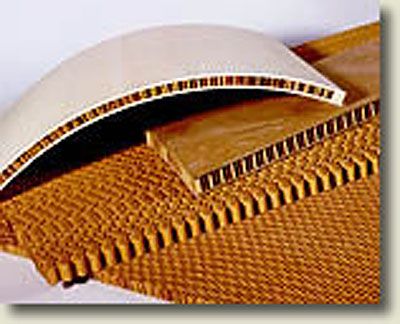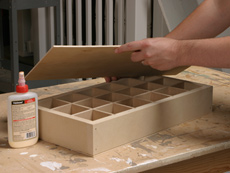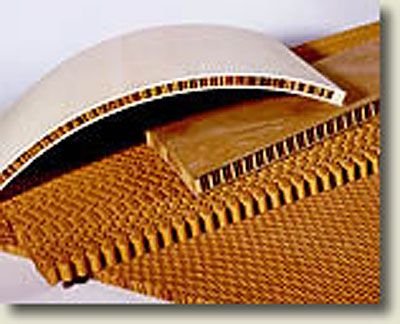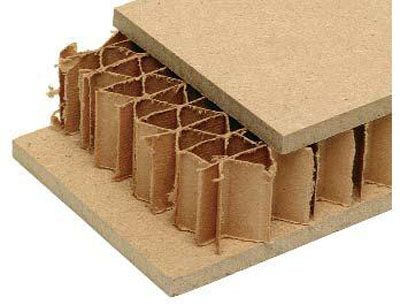
The honeycomb comes in different thicknesses.
Resin-impregnated honeycomb. Sounds serious, eh?
Well it’s seriously strong and stable, making it a great modern alternative to traditional torsion-box construction. The material is lightweight and inexpensive, and it’s available from Vacuum Pressing Systems in thicknesses of 1/2 in., 3/4 in., and 1 in. It can even be used in curved applications.
 |
Look familiar? It should. We’ve been covering traditional torsion box construction for years. It’s essentially the same method being used in resin-impregnated honeycomb. It’s so strong, in fact, that most manufacturers use it in steel door construction. |
We’re always looking for new ways of making furniture, and this stuff has great possibilities. I’ve never used it, but I’m looking for furniture makers who have. I’d like to check out what you’ve made with the honeycomb material. It doesn’t matter the form or style, the size or shape. Email your pics to me (tmckenna@taunton.com), along with a short description.
Who knows? Your furniture could become part of an article.
























Comments
Tom!
Good point. I never used HC for wood furniture but for fiberglass furniture. We make little tables for the boats we sell using HC or Divinycell, a very lite and resistant PVC structural foam. And the results are so strong, you will not believe.
I'll send some pics @ your email.
Best
Ari
Honeycomb sub-structures are great when designing a project that is intended to be strong, yet lightweight. Sailboat manufacuturing comes to mind. But, when making quality furniture, using genuine hardwoods is a tradition that is hard to beat. You can always tell when someone put quality in a project and that usually includes solid panels with no MDF cores or honeycombs. For the Shows and Displays Industry, lighweight and stregth are important, but longevity is secondary. Make it look good for several shows and design a new unit. Honeycomb sub-structure has its place, but not in fine furniture - sorry.
Hi AriCunha, I would be very much interested to get some pics.
Thank's
ottorauh@gmx.net
Honeycomb panels are used extensively in aircraft. Super-light, super strong. They often use advanced composited as a skin.
In the finer private jets and some boats, it's covered with fancy veneers.
As for whether furniture is 'fine' - I would apply Dunhill's maxim as a criterion. (which was recently quoted in a video on this site re. the Bridge City Block Plane)
"It must be useful. It must work dependably. It must be beautiful. It must last. It must be the best of its kind." (Alfred Dunhill's Maxim 1907)
I think we need to draw our own personal conclusions whether furniture using honeycomb panels could qualify.
My comment is slightly off target, so sorry, but I couldn't resist. What you are calling cardboard is actually properly called corrugated. Cardboard is the heavy board stock found in shoe boxes, for example. Corrugated, and corrugated boxes, is/are made from much lighter weight paperboard glued in flutes to one or more faces. So think about the strength in certain directions for lightweight corrugated and you should get a good idea how this impregnated honeycomb would work. And I disagree that it shouldn't be used in fine furniture. It should be used where it makes sense and functions well, for that is the foundation of all technological advances.
Tom,
I'm glad to hear you are considering to write an article on resin-impregnated honeycomb products for use in fine furniture-making.
When you look at furniture-making from a design perspective, there are certain times when it makes great sense to use it.
If your design includes a thick top, long shelf, or in an attempt to conserve precious, veneer-grade lumber with resawing, honeycomb offers an easy to use, cost AND TIME effective means to an end.
Many high end furniture makers use it and so should your readers if their projects call for it.
Donn
Honeycomb material is used in the production of cross country skis. It makes a stiff, light ski. Fischer has been using it for years, with great success.
Isn't HC the stuff used in hollow core doors? I transformed a hollow-core door into a portable tabletop to use over my dining room table for big gatherings at holidays. I trimmed it out, added pieces to attach it to the existing table and clear coated it. Instead of being able to seat 4-6, I can now seat 8 comfortably and 10 if needed. It's lightweight and easy to attach and remove. With a tablecloth over it, it looks like any dining room table. Without the tablecloth, it's an excellent game, jigsaw puzzle, or crafting surface.
Just to add a little humor. Some 30 years ago, I would make bets that I could balance a 6 volt railroad lantern battery on a single IBM punch card that was standing on its side on a desk. The secret of course was folding the card a few times i.e. corrugating. The Coke was great.
C.J. Conley Jr.
Since people have been veneering surfaces since the days of the Pharaohs, I don't see that putting fine burl veneer over RIH is somehow a perversion of fine furniture. Yes, I love solid wood but not when the humidity changes drastically and table tops start cracking. Also, I'm not as young as I once was (is anyone?) and the greatly reduced weight of a torsion box is mighty appealing, especially since there is no reduction in strength.
I design and build custom made wooden coffins. Believe it or not, some of the fancier lids weigh as much as 40 to 50 lbs. The honeycomb could be a great solution for me. I'm looking forward to your article and learning more about it -- especially where to find it.
Thanks
Bud Davis
http://www.vintagecoffins.com
Bud Davis, Coffins! Who knew.
I have been "repurposing" a lot of misc materials lately, and I recently picked up (6)78 x 40 x 1 3/8 oak veneered hollow core doors from IKEA for $50(clearance items). I have ripped these down for closet shelving and also constructed a simple 4 shelf bookcase. The panels are extremely strong, rigid, and hold a lot of weight without deflecting. Because I am not making the pieces from scratch, I have to work with the existing internal rib placement to connect fasteners. Small price to pay; more of a design challange.
I would consider making my own pieces for furniture if the honeycomb materials were readily available. I like the extra thick look without the weight.
Woah, marchmat, we've got an Ikea hacker in our midst! http://ikeahacker.blogspot.com/
Thanks for sharing. Stay tuned, we hope to have more content in the coming months about people working on similar projects using unorthodox materials. It'll be on our new StartWoodworking site and in a new intiative for FineWoodworking.
But never fear traditional people, we won't forget our roots! -Gina, FineWoodworking.com
Humm-
You gave me a great idea. It has to be a better insulator than solid wood. I'm going to build some beehive boxes using this technology. A sandwiched foam core is gong to be warmer in the winter & cooler in the summer, easier for the honeybees to regulate temperature.
Cliff
Very useful! One tip: It's not strong enough compression-wise to stand up to a hydraulic press. Use some solid stock of matching thickness to protect it from crushing when in the press.
Thanks! That's pretty cool stuff. Does it come with a foam core or just air? I'm thinking of building a Tiny House with either resin impregnated core or maybe a veneer torsion box core with foam for insulation. Has anyone compared these kind of cores? We're looking to build this summer. Thanks!
Log in or create an account to post a comment.
Sign up Log in